Nursing Strategies for Palliative Care: Mrs. Brown's Case Study
VerifiedAdded on 2020/11/23
|6
|1640
|218
Report
AI Summary
This report examines palliative care strategies for a 62-year-old retired woman, Mrs. Brown, who is suffering from acute breathlessness, coughing, and depression due to COPD. The assignment explores two priority nursing strategies: one focusing on breathlessness, including breathing exercises, coping strategies, medication, oxygen therapy, and self-management action plans; and another addressing depression through identifying symptoms, providing medications and psychotherapies, and focusing on safety, problem elimination, and maintaining a stable state. The report emphasizes a holistic approach to palliative care, aiming to improve the patient's quality of life by addressing both physical and mental symptoms, and reducing the impact of chronic illness. The strategies discussed are aimed at alleviating symptoms, improving overall health, and providing support for Mrs. Brown's condition. The report concludes that these strategies can significantly improve Mrs. Brown's condition and overall well-being.
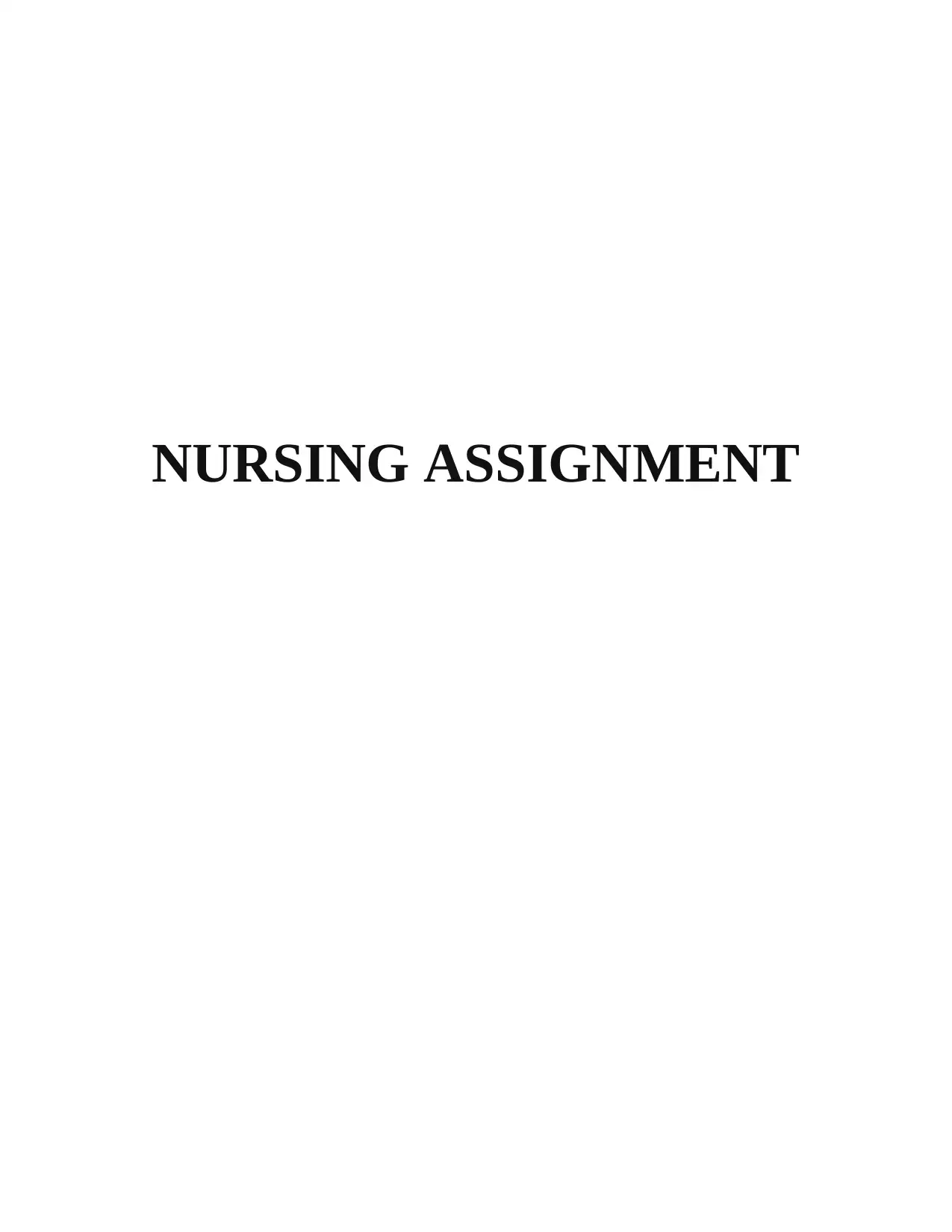
NURSING ASSIGNMENT
Paraphrase This Document
Need a fresh take? Get an instant paraphrase of this document with our AI Paraphraser
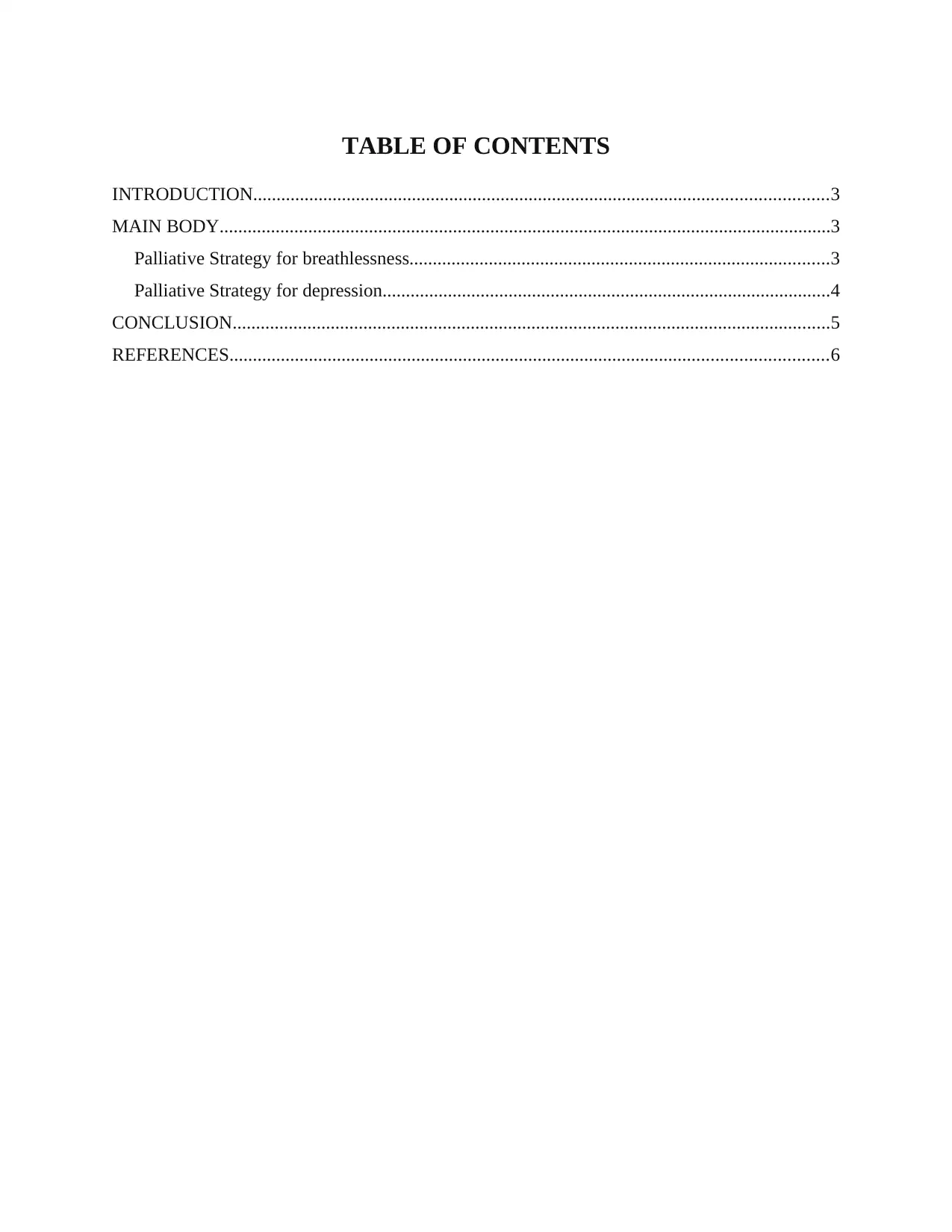
TABLE OF CONTENTS
INTRODUCTION...........................................................................................................................3
MAIN BODY...................................................................................................................................3
Palliative Strategy for breathlessness..........................................................................................3
Palliative Strategy for depression................................................................................................4
CONCLUSION................................................................................................................................5
REFERENCES................................................................................................................................6
INTRODUCTION...........................................................................................................................3
MAIN BODY...................................................................................................................................3
Palliative Strategy for breathlessness..........................................................................................3
Palliative Strategy for depression................................................................................................4
CONCLUSION................................................................................................................................5
REFERENCES................................................................................................................................6
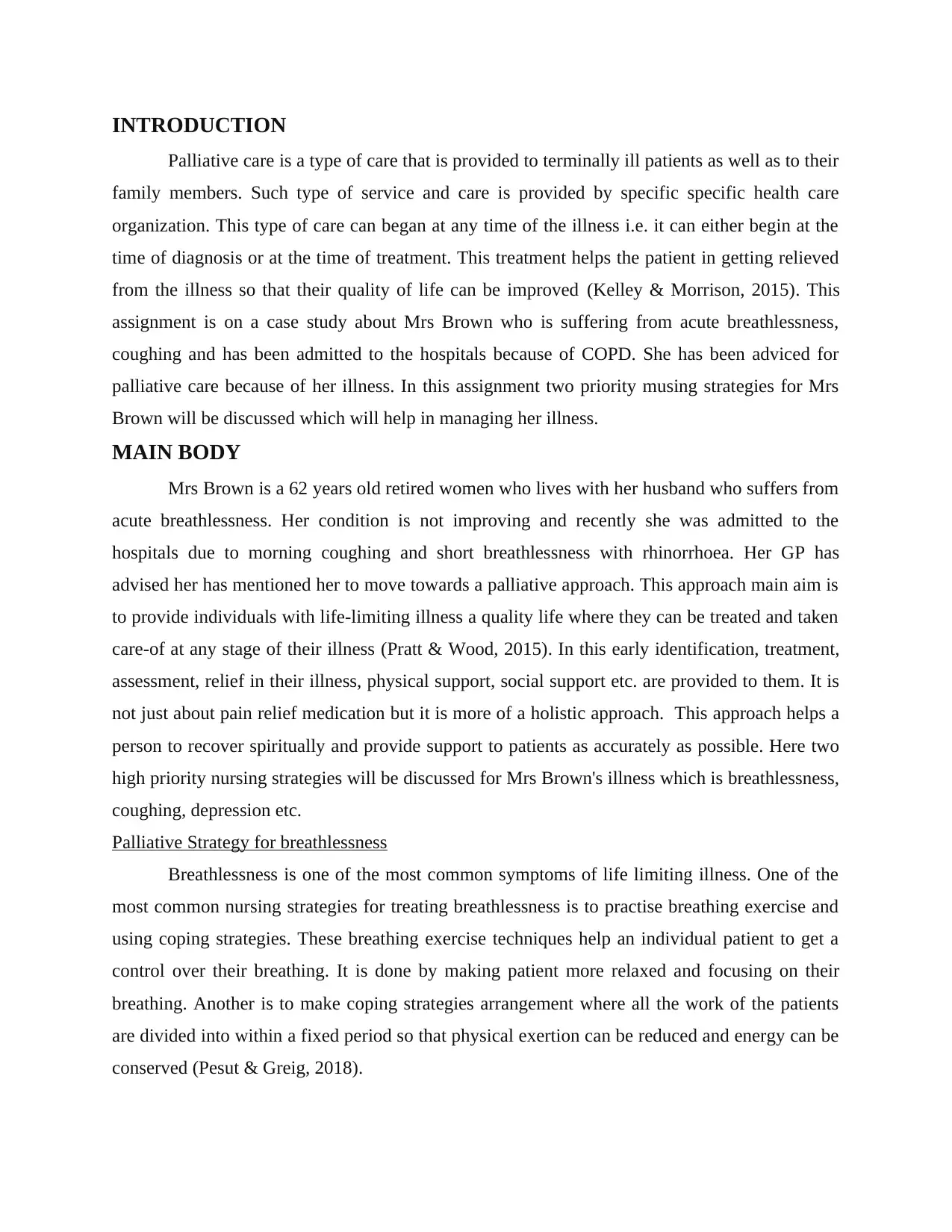
INTRODUCTION
Palliative care is a type of care that is provided to terminally ill patients as well as to their
family members. Such type of service and care is provided by specific specific health care
organization. This type of care can began at any time of the illness i.e. it can either begin at the
time of diagnosis or at the time of treatment. This treatment helps the patient in getting relieved
from the illness so that their quality of life can be improved (Kelley & Morrison, 2015). This
assignment is on a case study about Mrs Brown who is suffering from acute breathlessness,
coughing and has been admitted to the hospitals because of COPD. She has been adviced for
palliative care because of her illness. In this assignment two priority musing strategies for Mrs
Brown will be discussed which will help in managing her illness.
MAIN BODY
Mrs Brown is a 62 years old retired women who lives with her husband who suffers from
acute breathlessness. Her condition is not improving and recently she was admitted to the
hospitals due to morning coughing and short breathlessness with rhinorrhoea. Her GP has
advised her has mentioned her to move towards a palliative approach. This approach main aim is
to provide individuals with life-limiting illness a quality life where they can be treated and taken
care-of at any stage of their illness (Pratt & Wood, 2015). In this early identification, treatment,
assessment, relief in their illness, physical support, social support etc. are provided to them. It is
not just about pain relief medication but it is more of a holistic approach. This approach helps a
person to recover spiritually and provide support to patients as accurately as possible. Here two
high priority nursing strategies will be discussed for Mrs Brown's illness which is breathlessness,
coughing, depression etc.
Palliative Strategy for breathlessness
Breathlessness is one of the most common symptoms of life limiting illness. One of the
most common nursing strategies for treating breathlessness is to practise breathing exercise and
using coping strategies. These breathing exercise techniques help an individual patient to get a
control over their breathing. It is done by making patient more relaxed and focusing on their
breathing. Another is to make coping strategies arrangement where all the work of the patients
are divided into within a fixed period so that physical exertion can be reduced and energy can be
conserved (Pesut & Greig, 2018).
Palliative care is a type of care that is provided to terminally ill patients as well as to their
family members. Such type of service and care is provided by specific specific health care
organization. This type of care can began at any time of the illness i.e. it can either begin at the
time of diagnosis or at the time of treatment. This treatment helps the patient in getting relieved
from the illness so that their quality of life can be improved (Kelley & Morrison, 2015). This
assignment is on a case study about Mrs Brown who is suffering from acute breathlessness,
coughing and has been admitted to the hospitals because of COPD. She has been adviced for
palliative care because of her illness. In this assignment two priority musing strategies for Mrs
Brown will be discussed which will help in managing her illness.
MAIN BODY
Mrs Brown is a 62 years old retired women who lives with her husband who suffers from
acute breathlessness. Her condition is not improving and recently she was admitted to the
hospitals due to morning coughing and short breathlessness with rhinorrhoea. Her GP has
advised her has mentioned her to move towards a palliative approach. This approach main aim is
to provide individuals with life-limiting illness a quality life where they can be treated and taken
care-of at any stage of their illness (Pratt & Wood, 2015). In this early identification, treatment,
assessment, relief in their illness, physical support, social support etc. are provided to them. It is
not just about pain relief medication but it is more of a holistic approach. This approach helps a
person to recover spiritually and provide support to patients as accurately as possible. Here two
high priority nursing strategies will be discussed for Mrs Brown's illness which is breathlessness,
coughing, depression etc.
Palliative Strategy for breathlessness
Breathlessness is one of the most common symptoms of life limiting illness. One of the
most common nursing strategies for treating breathlessness is to practise breathing exercise and
using coping strategies. These breathing exercise techniques help an individual patient to get a
control over their breathing. It is done by making patient more relaxed and focusing on their
breathing. Another is to make coping strategies arrangement where all the work of the patients
are divided into within a fixed period so that physical exertion can be reduced and energy can be
conserved (Pesut & Greig, 2018).
⊘ This is a preview!⊘
Do you want full access?
Subscribe today to unlock all pages.

Trusted by 1+ million students worldwide
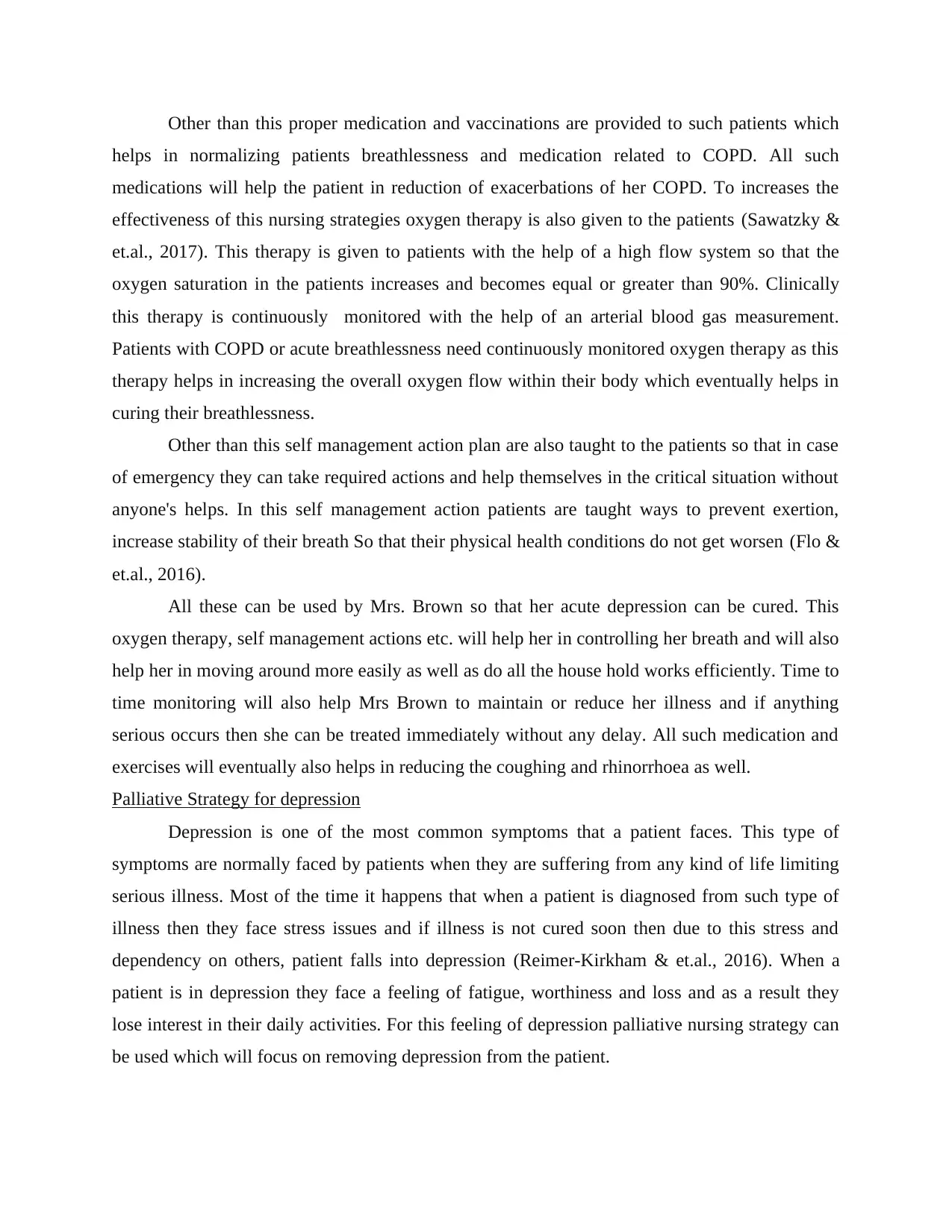
Other than this proper medication and vaccinations are provided to such patients which
helps in normalizing patients breathlessness and medication related to COPD. All such
medications will help the patient in reduction of exacerbations of her COPD. To increases the
effectiveness of this nursing strategies oxygen therapy is also given to the patients (Sawatzky &
et.al., 2017). This therapy is given to patients with the help of a high flow system so that the
oxygen saturation in the patients increases and becomes equal or greater than 90%. Clinically
this therapy is continuously monitored with the help of an arterial blood gas measurement.
Patients with COPD or acute breathlessness need continuously monitored oxygen therapy as this
therapy helps in increasing the overall oxygen flow within their body which eventually helps in
curing their breathlessness.
Other than this self management action plan are also taught to the patients so that in case
of emergency they can take required actions and help themselves in the critical situation without
anyone's helps. In this self management action patients are taught ways to prevent exertion,
increase stability of their breath So that their physical health conditions do not get worsen (Flo &
et.al., 2016).
All these can be used by Mrs. Brown so that her acute depression can be cured. This
oxygen therapy, self management actions etc. will help her in controlling her breath and will also
help her in moving around more easily as well as do all the house hold works efficiently. Time to
time monitoring will also help Mrs Brown to maintain or reduce her illness and if anything
serious occurs then she can be treated immediately without any delay. All such medication and
exercises will eventually also helps in reducing the coughing and rhinorrhoea as well.
Palliative Strategy for depression
Depression is one of the most common symptoms that a patient faces. This type of
symptoms are normally faced by patients when they are suffering from any kind of life limiting
serious illness. Most of the time it happens that when a patient is diagnosed from such type of
illness then they face stress issues and if illness is not cured soon then due to this stress and
dependency on others, patient falls into depression (Reimer‐Kirkham & et.al., 2016). When a
patient is in depression they face a feeling of fatigue, worthiness and loss and as a result they
lose interest in their daily activities. For this feeling of depression palliative nursing strategy can
be used which will focus on removing depression from the patient.
helps in normalizing patients breathlessness and medication related to COPD. All such
medications will help the patient in reduction of exacerbations of her COPD. To increases the
effectiveness of this nursing strategies oxygen therapy is also given to the patients (Sawatzky &
et.al., 2017). This therapy is given to patients with the help of a high flow system so that the
oxygen saturation in the patients increases and becomes equal or greater than 90%. Clinically
this therapy is continuously monitored with the help of an arterial blood gas measurement.
Patients with COPD or acute breathlessness need continuously monitored oxygen therapy as this
therapy helps in increasing the overall oxygen flow within their body which eventually helps in
curing their breathlessness.
Other than this self management action plan are also taught to the patients so that in case
of emergency they can take required actions and help themselves in the critical situation without
anyone's helps. In this self management action patients are taught ways to prevent exertion,
increase stability of their breath So that their physical health conditions do not get worsen (Flo &
et.al., 2016).
All these can be used by Mrs. Brown so that her acute depression can be cured. This
oxygen therapy, self management actions etc. will help her in controlling her breath and will also
help her in moving around more easily as well as do all the house hold works efficiently. Time to
time monitoring will also help Mrs Brown to maintain or reduce her illness and if anything
serious occurs then she can be treated immediately without any delay. All such medication and
exercises will eventually also helps in reducing the coughing and rhinorrhoea as well.
Palliative Strategy for depression
Depression is one of the most common symptoms that a patient faces. This type of
symptoms are normally faced by patients when they are suffering from any kind of life limiting
serious illness. Most of the time it happens that when a patient is diagnosed from such type of
illness then they face stress issues and if illness is not cured soon then due to this stress and
dependency on others, patient falls into depression (Reimer‐Kirkham & et.al., 2016). When a
patient is in depression they face a feeling of fatigue, worthiness and loss and as a result they
lose interest in their daily activities. For this feeling of depression palliative nursing strategy can
be used which will focus on removing depression from the patient.
Paraphrase This Document
Need a fresh take? Get an instant paraphrase of this document with our AI Paraphraser
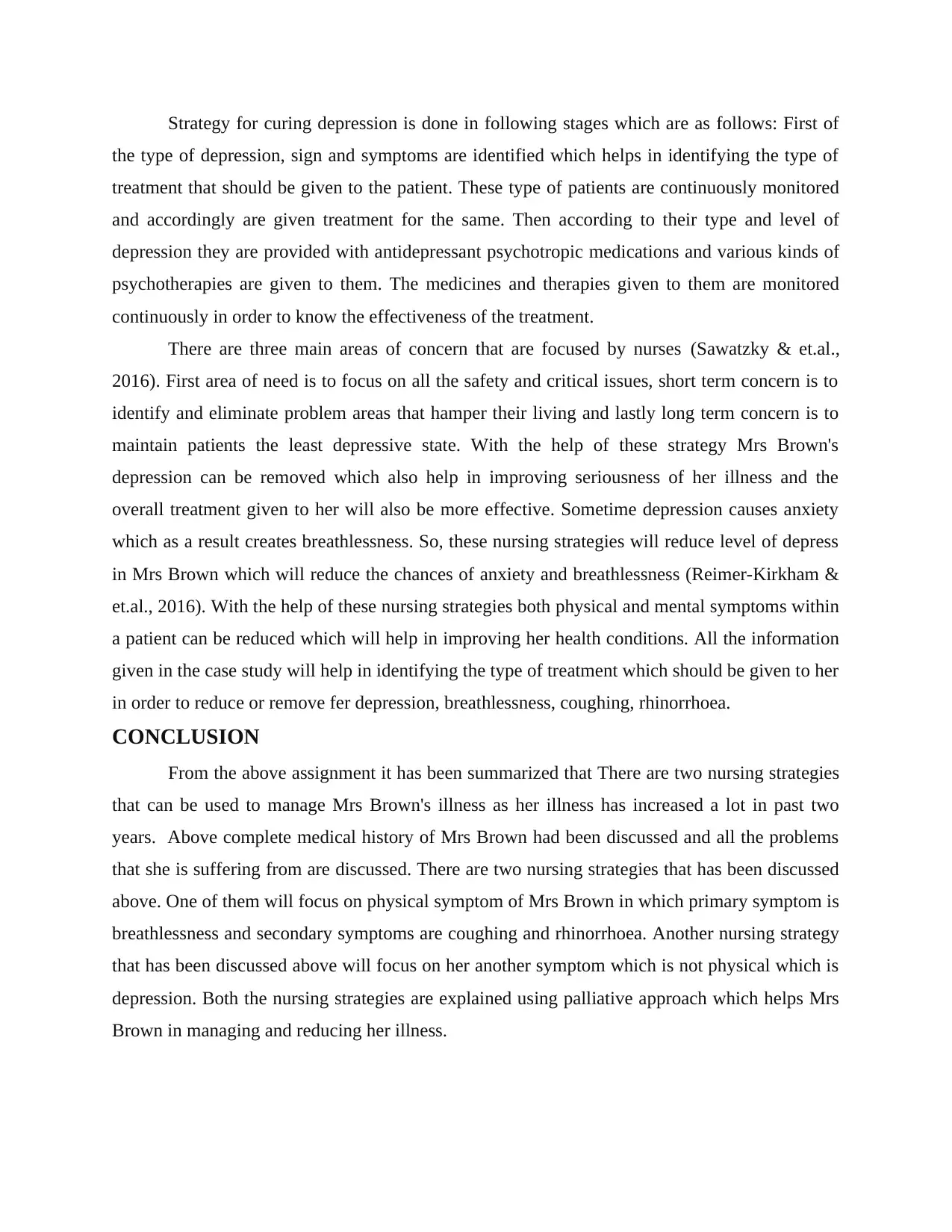
Strategy for curing depression is done in following stages which are as follows: First of
the type of depression, sign and symptoms are identified which helps in identifying the type of
treatment that should be given to the patient. These type of patients are continuously monitored
and accordingly are given treatment for the same. Then according to their type and level of
depression they are provided with antidepressant psychotropic medications and various kinds of
psychotherapies are given to them. The medicines and therapies given to them are monitored
continuously in order to know the effectiveness of the treatment.
There are three main areas of concern that are focused by nurses (Sawatzky & et.al.,
2016). First area of need is to focus on all the safety and critical issues, short term concern is to
identify and eliminate problem areas that hamper their living and lastly long term concern is to
maintain patients the least depressive state. With the help of these strategy Mrs Brown's
depression can be removed which also help in improving seriousness of her illness and the
overall treatment given to her will also be more effective. Sometime depression causes anxiety
which as a result creates breathlessness. So, these nursing strategies will reduce level of depress
in Mrs Brown which will reduce the chances of anxiety and breathlessness (Reimer‐Kirkham &
et.al., 2016). With the help of these nursing strategies both physical and mental symptoms within
a patient can be reduced which will help in improving her health conditions. All the information
given in the case study will help in identifying the type of treatment which should be given to her
in order to reduce or remove fer depression, breathlessness, coughing, rhinorrhoea.
CONCLUSION
From the above assignment it has been summarized that There are two nursing strategies
that can be used to manage Mrs Brown's illness as her illness has increased a lot in past two
years. Above complete medical history of Mrs Brown had been discussed and all the problems
that she is suffering from are discussed. There are two nursing strategies that has been discussed
above. One of them will focus on physical symptom of Mrs Brown in which primary symptom is
breathlessness and secondary symptoms are coughing and rhinorrhoea. Another nursing strategy
that has been discussed above will focus on her another symptom which is not physical which is
depression. Both the nursing strategies are explained using palliative approach which helps Mrs
Brown in managing and reducing her illness.
the type of depression, sign and symptoms are identified which helps in identifying the type of
treatment that should be given to the patient. These type of patients are continuously monitored
and accordingly are given treatment for the same. Then according to their type and level of
depression they are provided with antidepressant psychotropic medications and various kinds of
psychotherapies are given to them. The medicines and therapies given to them are monitored
continuously in order to know the effectiveness of the treatment.
There are three main areas of concern that are focused by nurses (Sawatzky & et.al.,
2016). First area of need is to focus on all the safety and critical issues, short term concern is to
identify and eliminate problem areas that hamper their living and lastly long term concern is to
maintain patients the least depressive state. With the help of these strategy Mrs Brown's
depression can be removed which also help in improving seriousness of her illness and the
overall treatment given to her will also be more effective. Sometime depression causes anxiety
which as a result creates breathlessness. So, these nursing strategies will reduce level of depress
in Mrs Brown which will reduce the chances of anxiety and breathlessness (Reimer‐Kirkham &
et.al., 2016). With the help of these nursing strategies both physical and mental symptoms within
a patient can be reduced which will help in improving her health conditions. All the information
given in the case study will help in identifying the type of treatment which should be given to her
in order to reduce or remove fer depression, breathlessness, coughing, rhinorrhoea.
CONCLUSION
From the above assignment it has been summarized that There are two nursing strategies
that can be used to manage Mrs Brown's illness as her illness has increased a lot in past two
years. Above complete medical history of Mrs Brown had been discussed and all the problems
that she is suffering from are discussed. There are two nursing strategies that has been discussed
above. One of them will focus on physical symptom of Mrs Brown in which primary symptom is
breathlessness and secondary symptoms are coughing and rhinorrhoea. Another nursing strategy
that has been discussed above will focus on her another symptom which is not physical which is
depression. Both the nursing strategies are explained using palliative approach which helps Mrs
Brown in managing and reducing her illness.
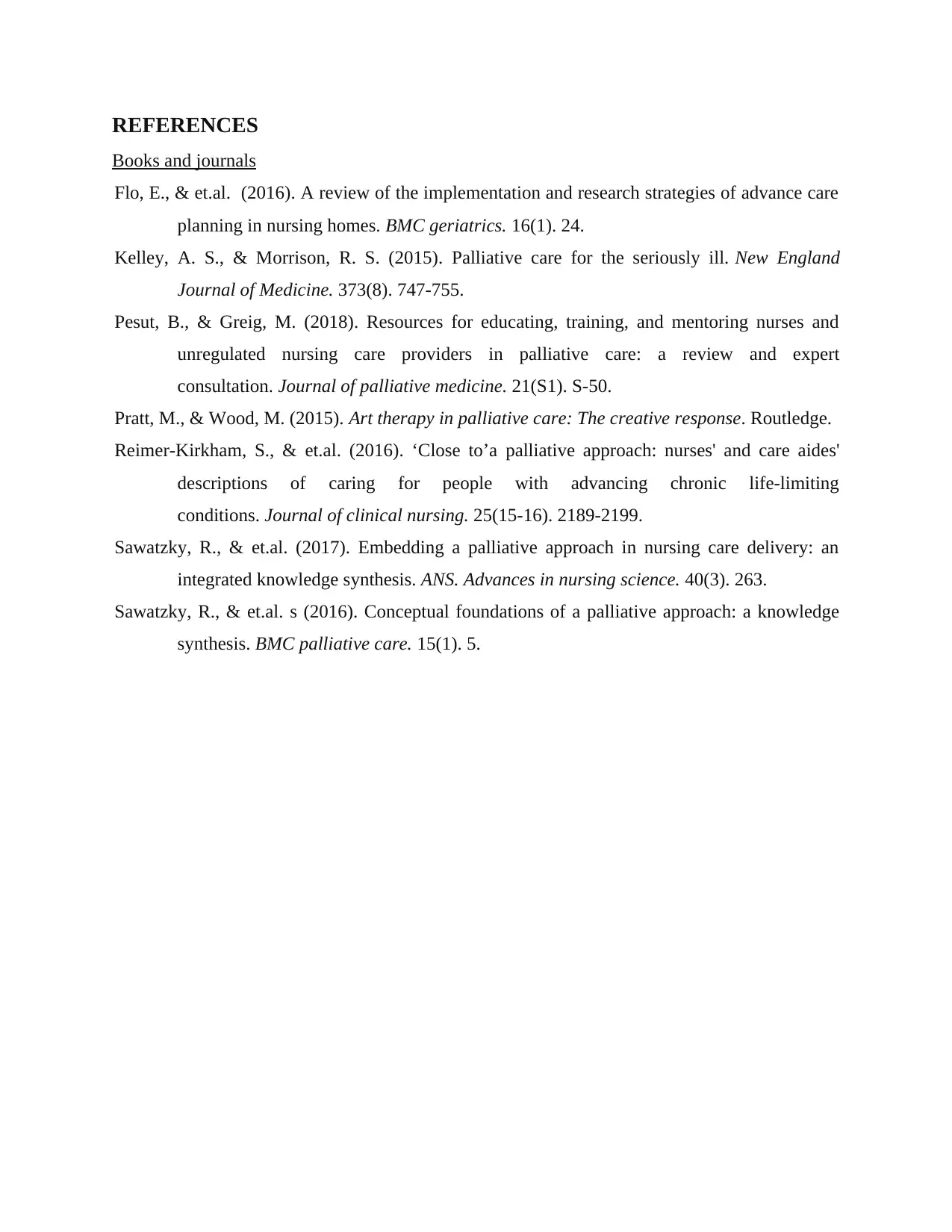
REFERENCES
Books and journals
Flo, E., & et.al. (2016). A review of the implementation and research strategies of advance care
planning in nursing homes. BMC geriatrics. 16(1). 24.
Kelley, A. S., & Morrison, R. S. (2015). Palliative care for the seriously ill. New England
Journal of Medicine. 373(8). 747-755.
Pesut, B., & Greig, M. (2018). Resources for educating, training, and mentoring nurses and
unregulated nursing care providers in palliative care: a review and expert
consultation. Journal of palliative medicine. 21(S1). S-50.
Pratt, M., & Wood, M. (2015). Art therapy in palliative care: The creative response. Routledge.
Reimer‐Kirkham, S., & et.al. (2016). ‘Close to’a palliative approach: nurses' and care aides'
descriptions of caring for people with advancing chronic life‐limiting
conditions. Journal of clinical nursing. 25(15-16). 2189-2199.
Sawatzky, R., & et.al. (2017). Embedding a palliative approach in nursing care delivery: an
integrated knowledge synthesis. ANS. Advances in nursing science. 40(3). 263.
Sawatzky, R., & et.al. s (2016). Conceptual foundations of a palliative approach: a knowledge
synthesis. BMC palliative care. 15(1). 5.
Books and journals
Flo, E., & et.al. (2016). A review of the implementation and research strategies of advance care
planning in nursing homes. BMC geriatrics. 16(1). 24.
Kelley, A. S., & Morrison, R. S. (2015). Palliative care for the seriously ill. New England
Journal of Medicine. 373(8). 747-755.
Pesut, B., & Greig, M. (2018). Resources for educating, training, and mentoring nurses and
unregulated nursing care providers in palliative care: a review and expert
consultation. Journal of palliative medicine. 21(S1). S-50.
Pratt, M., & Wood, M. (2015). Art therapy in palliative care: The creative response. Routledge.
Reimer‐Kirkham, S., & et.al. (2016). ‘Close to’a palliative approach: nurses' and care aides'
descriptions of caring for people with advancing chronic life‐limiting
conditions. Journal of clinical nursing. 25(15-16). 2189-2199.
Sawatzky, R., & et.al. (2017). Embedding a palliative approach in nursing care delivery: an
integrated knowledge synthesis. ANS. Advances in nursing science. 40(3). 263.
Sawatzky, R., & et.al. s (2016). Conceptual foundations of a palliative approach: a knowledge
synthesis. BMC palliative care. 15(1). 5.
⊘ This is a preview!⊘
Do you want full access?
Subscribe today to unlock all pages.

Trusted by 1+ million students worldwide
1 out of 6
Related Documents
Your All-in-One AI-Powered Toolkit for Academic Success.
+13062052269
info@desklib.com
Available 24*7 on WhatsApp / Email
![[object Object]](/_next/static/media/star-bottom.7253800d.svg)
Unlock your academic potential
Copyright © 2020–2025 A2Z Services. All Rights Reserved. Developed and managed by ZUCOL.





